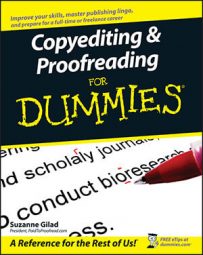Proofreaders don't see things the way other people do. They scrutinize. When something is awry, their warning buzzers go off and they swoop down for a better look. They are charged with catching the errors that everyone, including the copyeditor, has missed.
What separates good proofreaders from bad is practice. The more you do it, the better (and faster) you become at catching errors. Proofreaders check for many of the same things copyeditors do, but proofreaders put an extra emphasis on catching the kinds of errors others are likely to miss:
- Alignment: Proofreaders scan margins, bulleted lists, and everything else that is supposed to align with something else.
- Alphabetized lists and sequences: Proofreaders have a field day correcting lists that are improperly alphabetized. For them, alphabetizing lists is like shooting fish in a barrel.
- Captions: Proofreaders know that captions on photos and illustrations are often not reviewed carefully by others. Copyeditors may intend to go back and read captions after completing the editing of the main copy, but they often forget to.
- Columns: Proofreaders always make certain that columns are formatted correctly.
- Dates: Dates are notorious for being incorrect. When a day of the week is mentioned with a date, proofreaders always check the calendar to make sure that the day of the week and the date correspond.
- Headlines: Proofreaders double-check headlines. When a headline has an error, you don't want to be the person who missed it.
- Numbers: It's easy for writers to mistype a number. Proofreaders review them carefully — especially if they are connected to dollar signs.
- Spelling of names: Proofreaders check the spelling of personal and organizational names against other sources (such as Web sites) when possible.
If copyeditors are the gatekeepers charged with protecting copy against bad writing, proofreaders stamp the admission tickets.
Proofreaders try to keep the above elements consistent with the style of the particular publisher for whom they are working. The house style, or style sheet, is a printed document that shows how particular parts of language should be written (such as using one space after a period, not two). When an element isn't addressed by the style sheet, the publisher has a particular style guide to follow, such as The New York Times Manual of Style and Usage. The style guide explains things like when to use "each other" and when to use "one another." Lastly, the publisher has a preferred dictionary to give the final word on spelling.
When a proofreader is in doubt about anything, she should look it up, making sure to obey the hierarchy of resources:
1. House style sheet
2. Style guide
3. Dictionary

